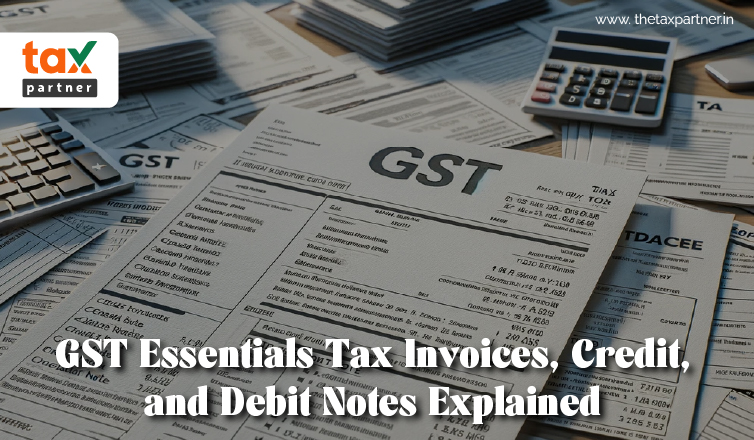GST Essentials: Tax Invoices, Credit, and Debit Notes Explained
GST Essentials: Tax Invoices, Credit, and Debit Notes Explained
Author- Tanvi Thapliyal
The Goods and Services Tax (GST) system is a crucial part of modern taxation, bringing about a significant change in how goods and services are taxed worldwide. The Goods and Services Tax (GST) was introduced to make the tax system more efficient and promote economic growth. It replaces many different indirect taxes with a single tax system, making it easier for businesses to comply with tax regulations and avoiding the problem of double taxation.
When it comes to GST, tax invoices, credit notes, and debit notes play a crucial role for both suppliers and recipients. These documents are essential for transparent and efficient transactions. They validate the legality of exchanges and ensure compliance with regulatory requirements.
Tax invoices are extremely important in the GST ecosystem. In simple terms, receipts are physical proof of a trade or service, providing a wide range of information such as the names of the people involved and the specific details of the transaction. Not having a valid tax invoice means that registered individuals cannot take advantage of the benefits provided by GST. This highlights how important this document is.
Furthermore, when there are differences in the taxable value or tax charged on the original invoice, credit notes and debit notes are used to address these discrepancies. These documents serve as a way to fix any mistakes or missing information that occurred during the initial transaction. These instruments, such as credit notes for addressing excess tax charged or deficiencies in supply, and debit notes for remedying shortfalls in tax charged or supply, play a crucial role in ensuring fairness and accuracy in GST transactions.
Basically, tax invoices, credit notes, and debit notes play a very important role in GST transactions. Not only do they validate the legality of exchanges, but they also play a crucial role in ensuring compliance with GST regulations. Businesses can confidently navigate the complexities of the GST regime by understanding and following the details of these documents. This will promote transparency, efficiency, and growth in the tax landscape.
Essentials Of Tax Invoice:
When it comes to Goods and Services Tax (GST), a tax invoice is a really important document. It represents a transaction and is crucial for making sure everything is done according to the rules. A tax invoice is required by GST regulations and it includes several important elements. These elements are crucial for maintaining transparency, accuracy, and eligibility for GST benefits.
-
The tax invoice should clearly display the name and address of the supplier who is registered under GST. The purpose of this information is to confirm the identity of the person or organisation starting the transaction.
-
It is equally important to include the name and address of the person or company who will be receiving the goods or services. It helps both parties by making it clear who is receiving the supply and also helps with keeping records.
-
Both the supplier and the recipient must clearly state their GST Identification Number (GSTIN) on the tax invoice. This helps to identify and confirm the registered entities that are involved in the transaction.
-
The tax invoice should clearly state the value of the goods or services that are subject to tax, as well as the amount of tax that is applicable based on the relevant GST rate. This information helps to measure the financial aspects of the transaction and makes sure that tax calculations are done correctly.
-
Invoice Value: Please make sure to include the total amount of the invoice, which includes both the taxable value and the tax amount. The total consideration payable by the recipient for the supply is represented by this and it serves as an important financial indicator.
-
It is important to have detailed information about the quantity, rate, and description of the goods or services provided. In addition, the Harmonised System of Nomenclature (HSN) code is used to classify goods, while the Service Accounting Code (SAC) is used for services. These codes help ensure uniformity in reporting and classification.
-
Make sure that each tax invoice has a unique identification number and the date it was issued. The sequential numbering system and chronological dating allow us to keep track of transactions and conduct audits.
-
Signature or digital signature of the supplier or an authorised representative is required for the tax invoice. This statement confirms that the document is genuine and acknowledges the completion of the transaction.
Tax invoices are not just records of transactions; they are essential tools for businesses that operate within the GST framework. These documents offer solid proof of the exchange of goods or services, creating a clear record of supply chain activities. Moreover, tax invoices play a crucial role in allowing businesses to claim input tax credits. This means they can offset the tax they paid on inputs against their output tax liability. If businesses don't have valid tax invoices, they might not be able to receive GST benefits and could face penalties for not following the rules.
To sum up, tax invoices are more than just administrative necessities. They are actually important tools for businesses to handle the complexities of the GST system. Businesses can ensure compliance, transparency, and eligibility for GST benefits by following the prescribed format and including all necessary details. This will help foster efficiency and growth in the tax landscape.
Credit Notes and Debit Notes
In the ever-changing world of Goods and Services Tax (GST), credit notes and debit notes play an important role in correcting errors and promoting fairness in transactions. These documents have specific purposes in dealing with mistakes or missing information that may occur during GST transactions. Their main goal is to promote transparency and ensure compliance within the system.
Definition and roles:
Credit Note
-
A credit note is a document that a supplier gives to a recipient to show that the amount the recipient needs to pay has been reduced.
-
Typically, a credit note is issued when the amount of tax charged in the original tax invoice is higher than the actual tax payable for the supply.
-
Credit notes are basically used to correct situations where too much tax was charged or there were mistakes in the supply, so that the transaction is fair and accurate.
Debit Note
-
A debit note is a document issued by a supplier to a recipient. It is used to indicate that the amount payable by the recipient has increased.
-
Debit notes are usually issued when the amount of tax or taxable value mentioned in the original tax invoice is less than the actual amount that should be paid for the supply.
-
These notes discuss situations where there are discrepancies in the amount of tax charged or the supply of goods, with the goal of ensuring fair treatment for both parties involved.
Scenarios for Issuance:
Here are some situations where credit notes are issued:
-
Excess Tax Charged: This occurs when the amount of tax charged on the original tax invoice is more than the actual tax liability for the supply.
-
Supply Deficiencies occur when there are issues with the quantity or quality of goods or services provided, resulting in a subpar transaction.
Debit notes are usually issued in situations like:
-
Shortfalls in Tax Charged: This occurs when the amount of tax charged in the original tax invoice is less than the actual tax liability for the supply.
-
Shortfalls in supply occur when there are issues with the quantity or quality of goods or services provided, leading to a subpar transaction.
The importance of issuing credit notes and debit notes in a timely manner
Issuing credit notes and debit notes within the same financial year as the original invoice is very important for a few reasons:
-
Compliance is important because issuing documents in a timely manner helps us follow regulatory requirements and stay in line with GST regulations.
-
Promptly fixing any mistakes helps ensure that financial reports and tax calculations are accurate.
-
When credit notes are issued within the required timeframe, recipients can claim input tax credits, which helps them maximise their tax benefits.
-
Having a timely issuance of transactions creates a clear and chronological audit trail, which helps with transparency and accountability.
Overall, credit notes and debit notes are important for correcting errors and promoting fairness in GST transactions. These documents, such as credit notes for excess tax charged or deficiencies in supply, and debit notes for shortfalls in tax charged or supply, play an important role in ensuring accuracy and fairness within the GST framework. Furthermore, it is crucial to issue these documents in the same financial year as the original invoice. This practice ensures compliance, accuracy, and transparency in the GST regime.
Regulatory Compliance for Issuing Credit Notes and Debit Notes under GST:
When it comes to issuing credit notes and debit notes under the Goods and Services Tax (GST) regime, it's important to follow the regulatory requirements carefully. This ensures that everything is transparent, accurate, and in compliance with the rules. Now, let's explore the important rules and regulations that control the issuance of these documents:
-
Make sure to declare any credit notes for returns within the specified timelines.
-
As per the GST regulations, people who are registered need to report credit notes in their GST returns within specific timeframes.
-
Include any credit notes that were issued during a specific tax period when you file your return for that same period. By doing this, it makes sure that any changes to the amount of taxes owed are correctly shown in the appropriate tax form.
-
It's important to remember that credit notes need to be declared within six months from the end of the relevant financial year or any other date specified by the government.
-
When credit notes are declared on time, it helps businesses reconcile their input tax credits accurately. This allows them to take advantage of eligible tax benefits.
-
Complying with government-prescribed formats and guidelines is important.
-
When it comes to credit notes and debit notes, it's important to follow the formats and guidelines set by the government under GST regulations.
-
The government has established specific formats for credit notes and debit notes. These formats outline the mandatory details that must be included in these documents.
-
Businesses need to make sure they accurately prepare credit notes and debit notes following the prescribed formats. This includes including all necessary information like invoice details, reasons for issuing the notes, and any adjustments to taxable amounts.
-
When you follow the prescribed formats and guidelines, it helps to make sure that all the documentation of credit and debit transactions is consistent and standardised. This makes it easier to keep records and conduct audits efficiently.
-
The importance of adhering to regulations is significant.
-
It is very important to follow the rules and regulations when issuing credit notes and debit notes in order to stay in line with GST laws and regulations.
-
If you don't follow the regulatory requirements, you could face penalties, fines, or other negative consequences, such as not being able to claim input tax credits.
-
Not following the rules can also cause problems for the business, like interruptions in operations, harm to the reputation, and legal consequences.
-
Businesses show their dedication to honesty, openness, and responsibility in GST transactions by following regulations. This helps build trust among stakeholders and regulatory authorities.
Overall, it is crucial to adhere to regulatory compliance when it comes to issuing credit notes and debit notes under GST. Businesses need to make sure they declare credit notes for returns on time, follow the formats and guidelines set by the government, and meet all regulatory requirements to stay compliant and avoid penalties. Businesses can maintain the integrity of GST transactions, reduce risks, and build trust and confidence in the tax system by following these regulations.
Conclusion
Overall, this article has discussed the important elements of tax invoices, credit notes, and debit notes in relation to the Goods and Services Tax (GST) system.
These are the main points that were discussed:
Tax invoices are important documents that include essential information about a transaction. This information typically includes the names and addresses of the parties involved, GST numbers, the value of the taxable goods or services, the amount of tax, the invoice number, and the date of the transaction. They are important for verifying transactions and accessing GST benefits.
Credit notes and debit notes have different purposes when it comes to fixing errors in GST transactions. Credit notes are used to address situations where too much tax has been charged or there are deficiencies in the supply. On the other hand, debit notes are used to cover situations where there are shortfalls in tax charged or supply.
It's really important to make sure that credit notes and debit notes are issued in the same financial year as the original invoice. This is necessary to comply with regulatory requirements. It is important to declare credit notes for returns on time and follow the formats and guidelines prescribed by the government. This helps to stay compliant and avoid penalties.
It is important to have a good understanding of tax invoices, credit notes, and debit notes in order to comply with GST regulations smoothly. These documents have multiple purposes. They not only validate transactions, but they also play a crucial role in correcting errors and ensuring fairness in transactions. Businesses can confidently navigate the complexities of the GST regime by following regulatory requirements and understanding the nuances of these documents. This promotes transparency and efficiency in the tax system.
Basically, tax invoices, credit notes, and debit notes are important parts of the GST system. They help ensure transparency, accuracy, and compliance in transactions. Properly understanding and using them are crucial for businesses to succeed in the constantly changing tax environment.
FAQs
What is a tax invoice under GST?
A tax invoice is a document issued by a registered supplier to the recipient, containing details of the supply of goods or services, including GST information.
Why is a tax invoice important under GST?
A tax invoice serves as proof of the supply of goods or services and is essential for claiming input tax credit under GST.
When should a tax invoice be issued?
A tax invoice should be issued at the time of supply, whether it is for goods or services.
What is a credit note under GST?
A credit note is a document issued by a supplier to a recipient, indicating a reduction in the amount payable by the recipient due to reasons like excess tax charged or deficiencies in supply.
When should a credit note be issued under GST?
A credit note should be issued when there are discrepancies in the taxable value or tax charged in the original tax invoice.
What is the purpose of issuing a credit note?
The purpose of a credit note is to rectify errors or omissions in the original tax invoice, ensuring fairness and accuracy in the transaction.
What is a debit note under GST?
A debit note is a document issued by a supplier to a recipient, indicating an increase in the amount payable by the recipient due to reasons like shortfalls in tax charged or supply.
When should a debit note be issued under GST?
A debit note should be issued when there are discrepancies in the taxable value or tax charged in the original tax invoice.
What is the significance of issuing credit and debit notes within the same financial year as the original invoice?
Issuing credit and debit notes within the same financial year ensures compliance with GST regulations and facilitates accurate reporting and reconciliation of transactions.
What are the consequences of not issuing credit and debit notes within the specified timelines?
Failure to issue credit and debit notes within the specified timelines may lead to non-compliance with GST regulations, resulting in penalties or disallowance of input tax credit.
Are there prescribed formats for credit and debit notes under GST?
Yes, the government provides prescribed formats for credit and debit notes, outlining the mandatory details to be included in these documents.
Can credit and debit notes be issued electronically?
Yes, credit and debit notes can be issued electronically, provided they comply with the requirements for electronic documentation and signatures.
How should businesses record credit and debit notes in their accounting records?
Businesses should accurately record credit and debit notes in their accounting records to ensure proper documentation and compliance with GST regulations.
Are there any specific guidelines for declaring credit notes in GST returns?
Yes, credit notes should be declared in GST returns within specified timelines, ensuring accurate reporting and reconciliation of transactions.
What should recipients do upon receiving a credit or debit note?
Recipients should verify the details mentioned in the credit or debit note and reconcile them with their records. If there are any discrepancies, they should communicate with the supplier to resolve the issue promptly.



